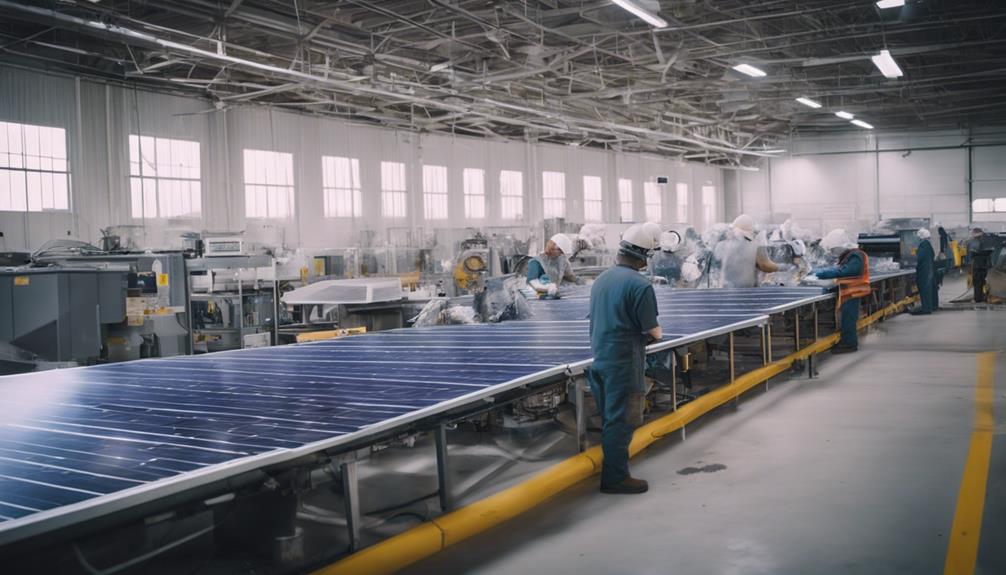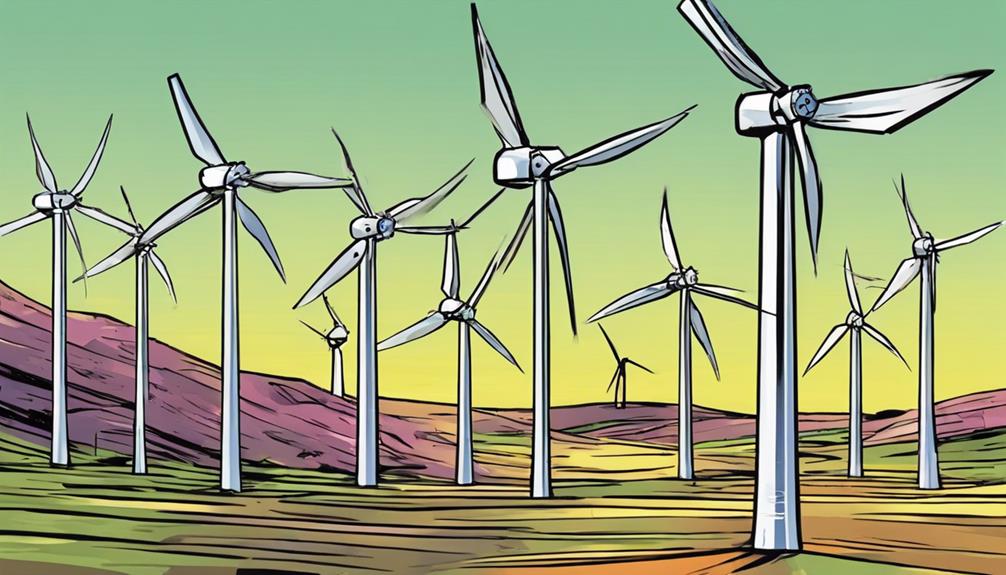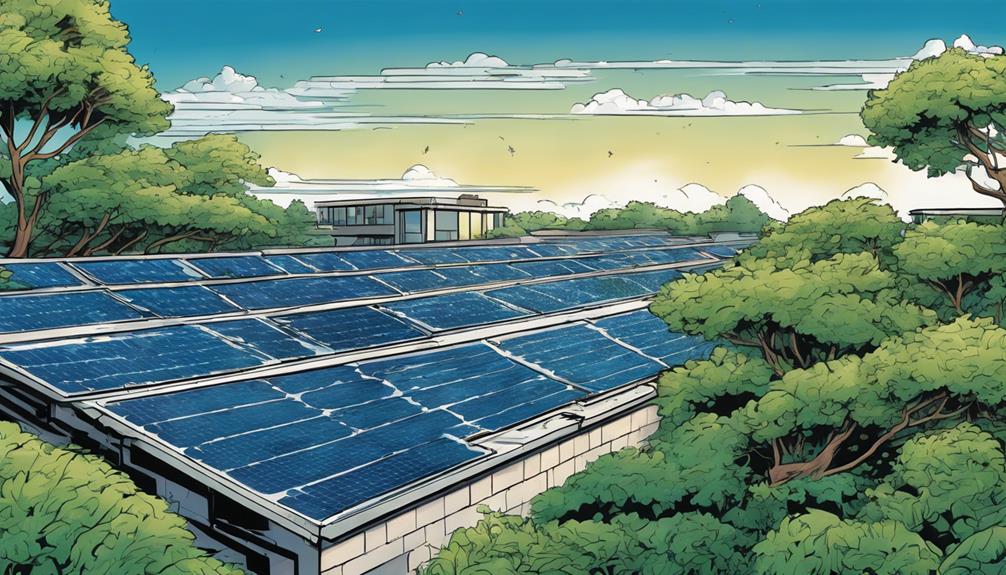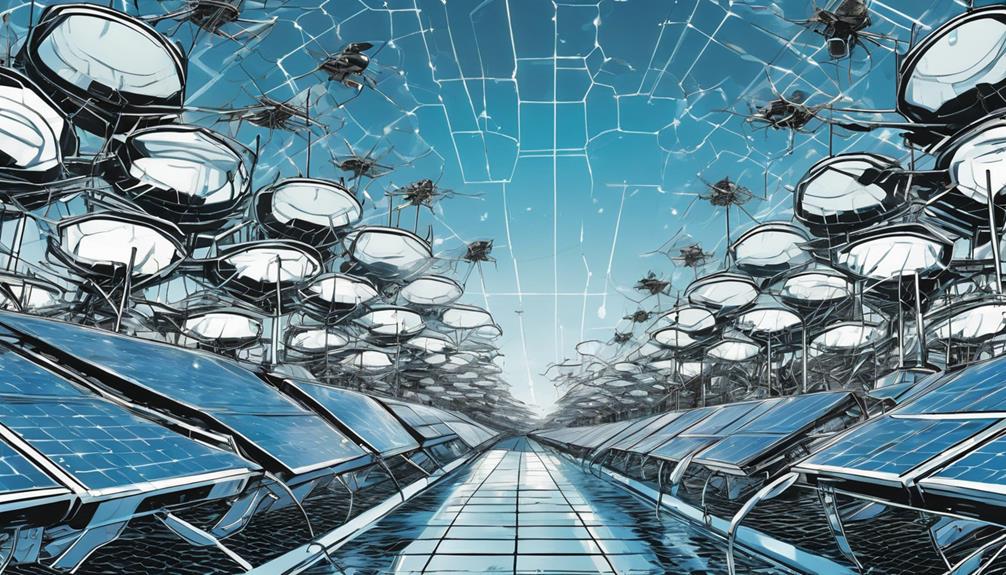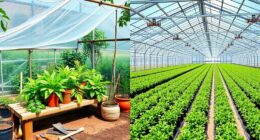Discover various solar photovoltaic cells – monocrystalline silicon for high efficiency, polycrystalline silicon for affordability, multi-junction cells for top efficiency, and thin film cells for flexibility. Gallium arsenide cells excel in space missions, while perovskite cells offer high energy conversion. These cells find applications across industries, driving advancements and boosting solar panel performance. Silicon cells last over 25 years, and thin film cells cater to aesthetic solar solutions. Get a glimpse into the world of solar cells and the array of benefits they offer in the renewable energy sector.
Key Takeaways
- Monocrystalline silicon cells offer high efficiency and long lifespans in solar applications.
- Polycrystalline silicon cells are cost-effective and commonly used in residential and commercial settings.
- Thin film cells are lightweight, flexible, and ideal for large-scale installations.
- Gallium arsenide cells are high efficiency but pricier, often used in space missions.
- Perovskite solar cells hold potential for high-energy conversion rates in various applications.
Silicon-Based Solar Cells
Silicon-based solar cells, known for their high efficiency and durability, are widely utilized in various applications. Monocrystalline silicon cells offer exceptional efficiency rates and long lifespans, making them perfect for applications with limited space constraints.
On the other hand, polycrystalline silicon cells, though slightly less efficient, are cost-effective to produce and commonly used in residential and commercial settings. Both monocrystalline and polycrystalline variants dominate the solar cell market due to their effectiveness in converting sunlight into energy.
These silicon solar cells are the most prevalent type of photovoltaic cells available, with a reputation for durability. Silicon modules can last over 25 years while retaining more than 80% of their original power output. The abundance of silicon makes these cells widely used in various applications ranging from solar panels to computer chips.
This widespread usage underscores the importance of silicon-based solar cells in the renewable energy sector.
Specialized Solar Cells

You may be interested to know that specialized solar cells offer varying levels of efficiency, with Multi-Junction Cells standing out for their high rates.
Thin Film Cells, on the other hand, are known for their lightweight and flexible nature, making them ideal for large-scale installations.
These unique characteristics of specialized solar cells play an important role in their diverse applications across different industries.
Efficiency of Specialized Cells
When evaluating the efficiency of specialized solar cells, it's essential to take into account the unique characteristics and applications of each type.
Monocrystalline cells exhibit higher efficiency levels compared to polycrystalline cells, making them suitable for space-constrained applications.
Polycrystalline cells, although more cost-effective, have a shorter lifespan.
Thin film cells, with lower efficiency rates, are favored for their lightweight, flexible nature and cost-effectiveness in large-scale installations.
Multi-junction cells stand out with the highest efficiency rates among specialized solar cells but involve complex manufacturing processes, commonly used in concentrated photovoltaic systems.
Gallium arsenide cells, known for their high efficiency, are often pricier and find applications in space missions due to their exceptional performance.
Understanding the efficiency attributes of monocrystalline, polycrystalline, thin film, multi-junction, and Gallium arsenide cells is vital for selecting the most suitable option based on specific project requirements.
Applications of Thin Film
Thin film solar cells offer versatile applications due to their lightweight and flexible nature, making them a practical choice for a wide range of solar energy projects. These cells, including Cadmium Telluride (CdTe) and Copper Indium Gallium Diselenide (CIGS), may have lower efficiency than crystalline silicon cells but are cost-effective for large installations.
One notable application is integrating thin film cells into building materials, providing an aesthetically pleasing option for solar energy generation. This integration allows for the creation of solar roofs, facades, or even windows that can generate electricity while blending seamlessly into the architectural design.
The lightweight and flexible characteristics of thin film cells make them suitable for curved surfaces or portable solar solutions, expanding their usability beyond traditional solar panels.
Ongoing research in the thin film technology sector, particularly in enhancing the efficiency and durability of CIGS and CdTe cells, continues to drive advancements in their applications across various industries.
Advanced Solar Cell Technologies

Bi-facial cells offer enhanced energy efficiency by capturing sunlight from both sides of the panel, maximizing performance and reducing costs.
Half-cell or cut cells increase efficiency by minimizing internal resistance in the solar cell structure, optimizing energy output.
Shingle solar cells, wired in parallel, decrease energy loss and boost efficiency, showing promise in solar energy generation.
Thin-film solar cells, known for being lightweight and flexible, cater to various applications, providing versatility in panel installations.
Perovskite solar cells, rapidly evolving in efficiency and performance, hold immense potential for high-energy conversion rates in future solar technology.
These advanced solar cell technologies focus on enhancing energy efficiency, reducing costs, and improving overall performance, paving the way for a more sustainable and effective solar energy landscape.
Incorporating these innovations into solar panel systems can lead to significant advancements in harnessing the power of the sun for renewable energy needs.
Characteristics of Solar Cells

Let's talk about the efficiency and installation space requirements of solar cells. Different types of solar cells vary in their efficiency levels and space needs for installation.
Understanding these characteristics can help you choose the most suitable option for your specific solar energy needs.
Efficiency of Cells
Among the key characteristics of solar cells, the efficiency of cells plays an essential role in determining their performance and suitability for various applications. Cell efficiency varies across different technologies, with monocrystalline silicon cells offering higher efficiency rates and extended lifespans, making them ideal for space-constrained applications.
On the other hand, polycrystalline silicon cells exhibit lower efficiency compared to monocrystalline cells but are cost-effective and commonly used in residential and commercial settings. Thin film cells, while having lower efficiency, feature a lightweight and flexible design, making them suitable for large-scale installations.
Multi-junction cells stand out with the highest efficiency rates but are complex and expensive to manufacture, often found in concentrated photovoltaic systems. Understanding the efficiency rates of different cell technologies is essential in selecting the most suitable option based on the specific requirements of the solar project.
Installation Space Requirements
When considering the characteristics of solar cells, the installation space requirements vary depending on the type of cell technology utilized. Monocrystalline silicon cells require less space for installation compared to polycrystalline cells, as they are more efficient. On the other hand, polycrystalline silicon cells have a larger space requirement due to their lower efficiency. Thin film cells offer a unique advantage as they can be integrated into building materials, making them suitable for space-constrained installations. Similarly, amorphous silicon solar cells, known for their flexibility and lightweight nature, provide versatility in installation options.
To illustrate the differences in space requirements for each type of solar cell technology, consider the following table:
| Solar Cell Type | Space Requirement |
|---|---|
| Monocrystalline Silicon | Less space needed |
| Polycrystalline Silicon | More space required |
| Thin Film Cells | Integrated into materials |
| Amorphous Silicon | Flexible and lightweight |
These characteristics make solar cells made of silicon suitable for varying environmental conditions, as they are less affected by shading, ensuring efficient energy production.
Global Production and Usage

Global production and usage of solar photovoltaic cells continues to expand rapidly in response to increasing energy demands and advancements in technology.
When it comes to PV cells, the global production landscape is diverse, with polycrystalline silicon cells dominating the market at approximately 70%. However, thin film solar cells, such as CIGS and CdTe cells, are gaining traction due to their higher efficiencies compared to traditional silicon cells.
Additionally, ongoing research into multi-junction solar cells aims to enhance efficiency and reduce costs for specialized applications. The global PV market is witnessing significant advancements in various solar cell technologies to cater to diverse energy needs.
Continuous efforts are being made to improve the efficiency and cost-effectiveness of solar cell production worldwide, reflecting the industry's commitment to sustainability and innovation.
Solar Cell Basics

Let's start by understanding the basics of solar cells.
These devices are structured to convert sunlight into electricity efficiently.
Their efficiency and lifespan are vital factors in determining their performance and longevity.
Cell Structure Overview
The structure of solar photovoltaic cells is vital for understanding how they convert sunlight into electricity efficiently. Here's a breakdown of the key components:
- Semiconductor Material: PV cells are made of semiconductor materials that absorb sunlight to create an electric current.
- Voltage Difference: When sunlight hits the cell, it generates a voltage difference by displacing electrons, enabling the flow of electricity.
- Metallic Contacts: These contacts help extract the electricity produced by the cell for external use.
- Efficiency: The efficiency of a PV cell is essential as it determines how well the cell can convert solar energy into electrical energy.
Understanding the structure of photovoltaic cells sheds light on how they function to harness solar energy effectively. By absorbing sunlight through semiconductor materials, creating a voltage difference, and utilizing metallic contacts, these cells efficiently convert solar energy into usable electricity. Achieving high efficiency is pivotal to maximizing the electricity generation potential of photovoltaic cells.
Efficiency and Lifespan
Understanding the efficiency and lifespan of different types of solar cells is key to maximizing their energy generation potential and longevity.
Monocrystalline silicon solar cells offer high efficiency rates ranging from 15% to 22% and exhibit a slow degradation rate of 0.25% to 0.5% per year, ensuring long-term performance.
On the other hand, polycrystalline silicon cells, though slightly less efficient at 15%-16%, are more cost-effective to produce.
Thin-film solar cells such as CIGS and CdTe variants have efficiency rates between 10% and 15%, making them suitable for large-scale installations.
Perovskite solar cells show promise with efficiencies currently around 20%-25% in lab settings, indicating potential for further advancements.
Silicon-based solar cells, including both monocrystalline and polycrystalline types, boast lifespans exceeding 25 years while maintaining over 80% of their original power output, making them reliable options for solar energy systems.
Silicon
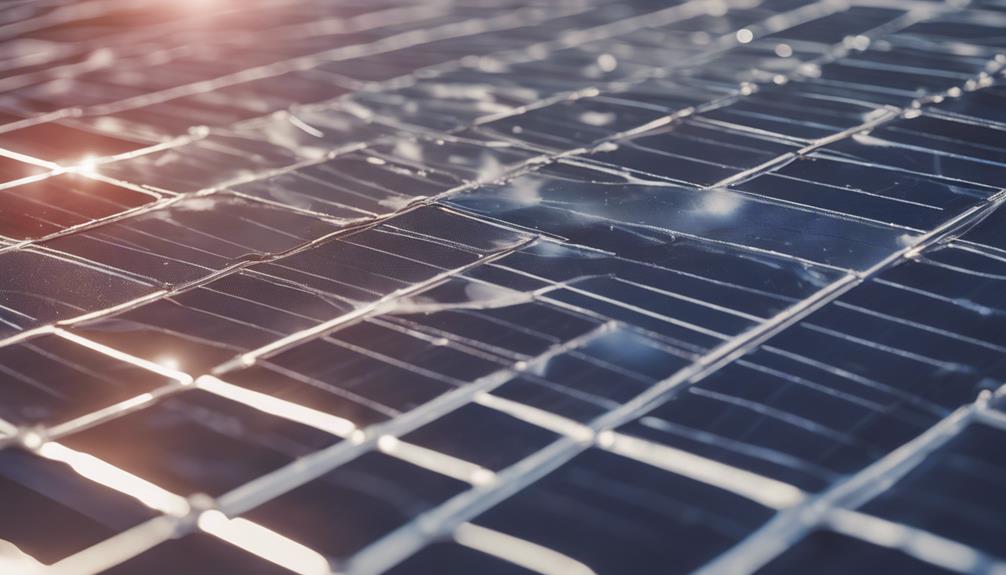
Silicon, being the most common semiconductor material used in solar cells, plays a crucial role in the efficiency of solar photovoltaic technology. Here are some key points about silicon in solar cells:
- Monocrystalline silicon cells are known for their high efficiency rates and extended lifespans, making them versatile for various applications.
- Polycrystalline silicon cells, while cost-effective to produce, exhibit lower efficiency and shorter lifespans compared to monocrystalline cells.
- The silicon atoms in solar cells form a crystal lattice structure that efficiently converts light energy into electricity, enhancing the overall performance.
- Silicon modules have an impressive longevity, often lasting over 25 years while maintaining more than 80% of their original power output.
Understanding the distinctions between monocrystalline and polycrystalline silicon cells and the importance of the crystal lattice structure can help you appreciate how silicon facilitates the conversion of light energy into usable electricity in solar photovoltaic systems.
Thin-Film Photovoltaics

Utilizing lightweight and flexible designs, thin-film solar cells offer versatility in various applications, such as building-integrated photovoltaics.
Common materials used in thin-film PV include Cadmium Telluride (CdTe) and Copper Indium Gallium Diselenide (CIGS), known for their cost-effective manufacturing processes.
While CdTe cells are economical, they exhibit lower efficiency compared to traditional silicon cells. On the other hand, CIGS cells face manufacturing challenges despite achieving high lab efficiencies.
These technologies are favored for large-scale installations due to their simple manufacturing procedures and higher absorption rates.
Ongoing research focuses on enhancing the efficiency and durability of thin-film solar cells, particularly in improving the longevity and performance of CdTe and CIGS technologies.
Innovations in thin-film PV aim to address these challenges and further expand their applications in the renewable energy sector.
Perovskite Photovoltaics
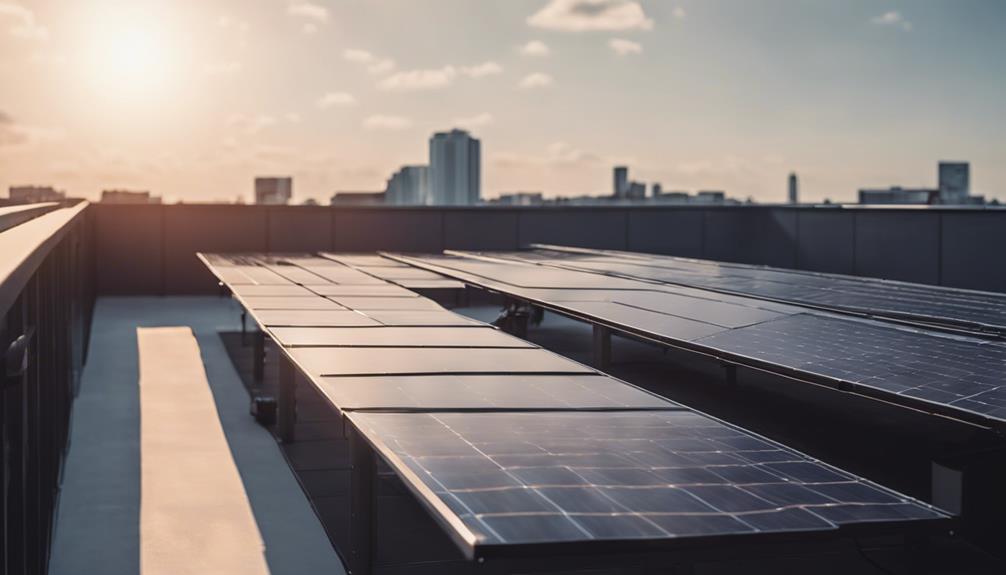
Perovskite photovoltaics, known for their characteristic crystal structure, hold significant potential for high efficiency in solar energy generation. When it comes to perovskite solar cells, several key points stand out:
- The crystal structure of perovskite cells contributes to their high efficiency potential.
- Layers of materials can be deposited onto a substrate to create perovskite cells, providing flexibility in design.
- Lab efficiencies of perovskite cells have been rapidly increasing, with some now comparable to traditional silicon cells.
- The commercial viability of perovskite cells depends on achieving durability and implementing low-cost manufacturing methods for mass production.
The aim of perovskite cells is to match the efficiencies of crystalline silicon cells while offering diverse applications due to their characteristics. As research progresses, the focus remains on optimizing these solar cells for widespread adoption in the renewable energy sector.
Organic Photovoltaics

Organic photovoltaics, composed of carbon-rich compounds, offer flexibility and diverse applications in solar energy generation. These organic photovoltaic cells can be tailored for specific functions and integrated into various supporting materials, making them versatile for different solar applications.
One significant advantage of organic photovoltaics is the potential for manufacturing in high volumes, which could lead to cost reductions and improved sustainability in solar energy production. While organic PV cells are currently about half as efficient as crystalline silicon cells, their capacity for innovation and customization presents opportunities for enhancing efficiency in the future.
Frequently Asked Questions
What Are the Different Types of Solar Photovoltaic Cells?
You have various options when it comes to solar photovoltaic cells. Monocrystalline cells offer high efficiency, polycrystalline cells are cost-effective, thin film cells are flexible, and multi-junction cells boast top efficiency. Advanced technologies like gallium arsenide and perovskite cells show promise too.
What Are the Applications of Solar Photovoltaic Cells?
Solar photovoltaic cells power a wide range of applications, from residential to industrial. They provide electricity for devices like calculators, street lights, and even entire communities through solar farms, offering sustainable energy solutions.
What Are the Most Common Photovoltaic Cells Used Today?
When it comes to solar photovoltaic cells, the most common types used today are monocrystalline silicon for high efficiency, polycrystalline silicon for cost-effectiveness, and thin-film cells for flexibility. Each has its unique advantages in various applications.
What Is the Difference Between N Type and P Type Solar Panels?
N-type solar panels have more electrons for better conductivity. P-type panels have electron holes aiding electron movement. Phosphorous doping in N-type and boron in P-type create an electric field at their junction, converting light to electricity.
How Can Different Types of Solar Photovoltaic Cells be Utilized in Different Areas?
There are various types of suitable solar areas where different types of solar photovoltaic cells can be utilized. Monocrystalline cells are ideal for small or restricted spaces, while polycrystalline cells are better suited for larger areas with ample sunlight. Thin-film cells are versatile and can be used in various types of suitable solar areas.
Conclusion
To sum up, solar photovoltaic cells come in various types, each with its own unique applications and benefits.
From silicon-based cells to advanced technologies like perovskite and organic photovoltaics, the potential for harnessing solar energy is vast.
Like a ray of sunshine breaking through the clouds, these innovative technologies offer a bright future for renewable energy production.
So, keep looking up – the future of solar power is shining bright!

